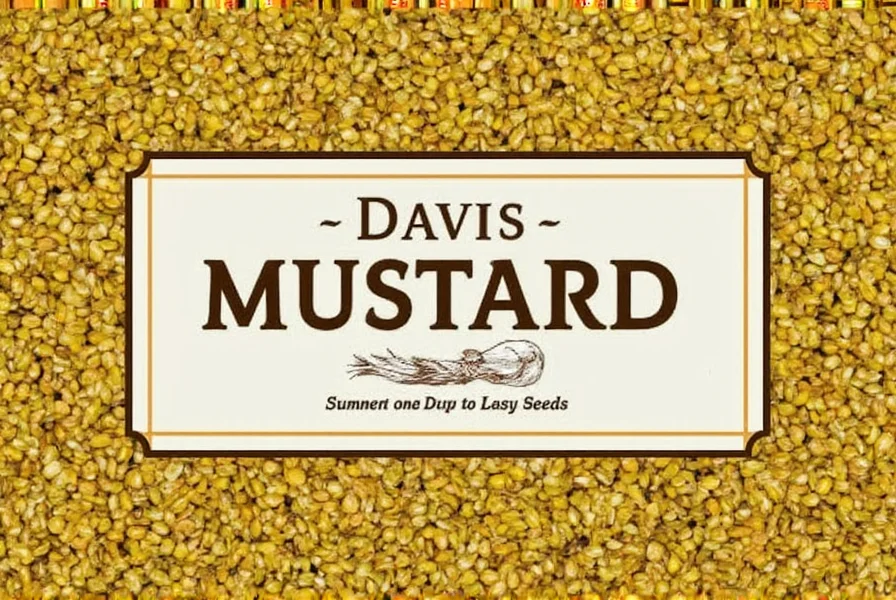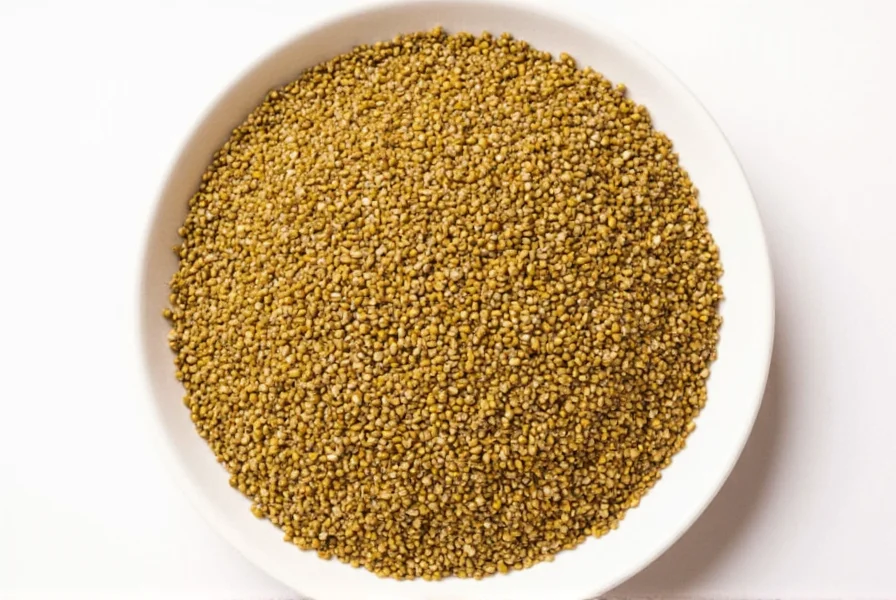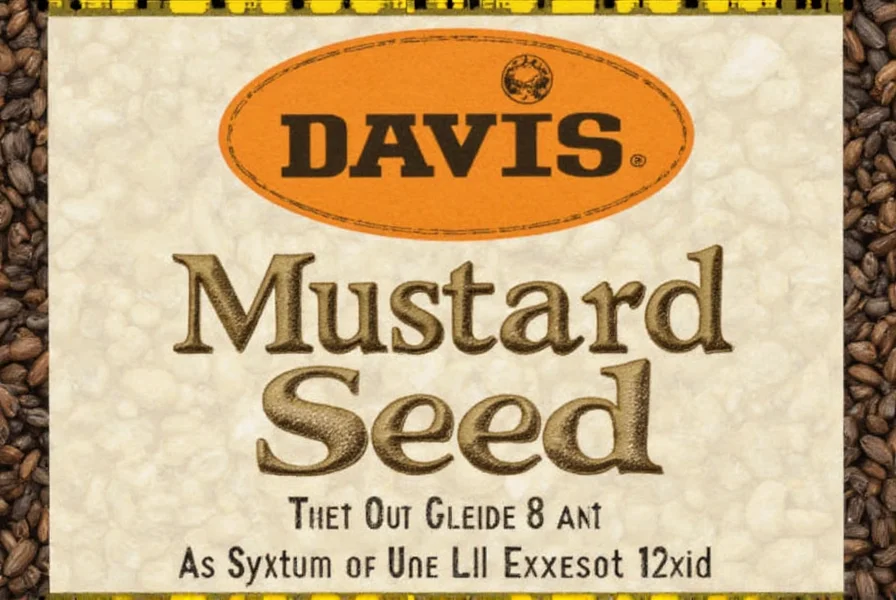Davis Mustard Seed has become a staple ingredient in many traditional Southern kitchens, prized for its consistent quality and distinctive flavor profile. Unlike standard yellow mustard seeds (Sinapis alba), which are milder and often used in ballpark mustards, Davis Mustard Seed belongs to the brown mustard family but offers a more nuanced taste experience that falls between the intense heat of black mustard seeds and the mildness of yellow varieties.
Understanding Davis Mustard Seed Characteristics
What sets Davis Mustard Seed apart from other varieties? This particular seed variety features several distinctive characteristics that make it valuable for specific culinary applications:
- Size and appearance: Slightly larger than standard brown mustard seeds with a deep reddish-brown color
- Flavor profile: Medium pungency (3-5 on a 1-10 heat scale) with earthy notes and subtle fruit undertones
- Oil content: Approximately 30-35%, contributing to its robust flavor when crushed
- Germination rate: Typically 85-90% when used for sprouting purposes
When comparing davis mustard seed versus regular mustard seed, the primary differences lie in consistency and regional adaptation. Davis seeds have been selectively cultivated to maintain uniform size and flavor characteristics, making them particularly reliable for commercial food production and consistent home cooking results.
| Mustard Seed Variety | Heat Level (1-10) | Primary Culinary Uses | Color |
|---|---|---|---|
| Davis Mustard Seed | 4-5 | Charleston mustard, pickling, Southern barbecue sauces | Deep reddish-brown |
| Yellow Mustard Seed | 2-3 | American-style hot dogs, ballpark mustard | Pale yellow |
| Black Mustard Seed | 7-9 | Indian curries, traditional European mustards | Dark brown to black |
| Standard Brown Mustard Seed | 5-6 | Dijon mustard, spicy condiments | Brown |
Culinary Applications of Davis Mustard Seed
The unique properties of Davis Mustard Seed make it particularly well-suited for specific culinary traditions. In Southern US cuisine, it's the preferred variety for creating authentic Charleston-style mustard—a sweet and tangy yellow mustard with a distinctive kick that serves as both a condiment and cooking ingredient.
When using davis mustard seed for pickling vegetables, the seeds contribute both flavor and visual appeal. The slightly larger size holds up better during the pickling process compared to finer mustard seed varieties, maintaining texture while releasing flavor compounds gradually. Many Southern pickle recipes specifically call for Davis Mustard Seed because of its reliable performance in vinegar-based brines.
Chefs who specialize in regional American cuisine often note that how to use davis mustard seed in barbecue sauce requires careful timing. Adding the seeds early in the cooking process allows their flavor to infuse the sauce more thoroughly, while adding them near the end preserves more of their distinctive texture and sharper flavor notes.

Sourcing and Substitution Options
Finding authentic Davis Mustard Seed can sometimes be challenging outside of specialty food stores or Southern regions. While it was historically associated with specific regional producers, today it's available through several specialty food distributors and online retailers that focus on Southern ingredients.
If you're searching for where to buy davis mustard seed near me, check with specialty spice shops, Southern food retailers, or online marketplaces that specialize in regional American ingredients. Some larger grocery chains with robust spice sections may carry it, particularly in Southern states.
When Davis Mustard Seed isn't available, proper substitution requires understanding what makes it unique. The best substitute depends on your specific recipe:
- For Charleston mustard: A 50/50 blend of standard brown mustard seed and yellow mustard seed
- For pickling: Standard brown mustard seed with a pinch of turmeric for color
- For dry rubs: Black mustard seed used sparingly (use 25% less due to higher heat)
Understanding difference between davis mustard seed and brown mustard seed is crucial for successful substitution. While they're closely related, Davis seeds have been selectively bred for more consistent size and slightly milder heat, so adjustments may be necessary when substituting.

Storage and Shelf Life Considerations
Proper storage significantly impacts the quality and shelf life of Davis Mustard Seed. Whole seeds maintain their flavor and potency much longer than ground mustard. For optimal freshness:
- Store in an airtight container away from light and moisture
- Keep in a cool, dark pantry (below 70°F/21°C) for up to 2 years
- Refrigeration extends shelf life to 3-4 years
- Freezing preserves quality for 5+ years (thaw before use)
When assessing how to tell if davis mustard seed is bad, look for these signs:
- Faded color (should be deep reddish-brown)
- Rancid or musty odor (fresh seeds have a clean, slightly peppery scent)
- Loss of pungency when crushed
- Visible moisture or mold
Historical Context and Regional Significance
Davis Mustard Seed has deep roots in Southern agricultural history. While not a formally registered cultivar, it emerged as a preferred variety among Southern farmers and food producers due to its reliable performance in the region's climate and its suitability for traditional recipes.
The name likely originated from regional seed producers rather than referring to a specific plant variety. Many food historians believe the "Davis" designation became associated with this particular mustard seed strain through agricultural extension programs in the early 20th century, when seed varieties were often named after prominent local farmers or agricultural researchers.
Today, what is davis mustard seed used for extends beyond traditional Southern cooking as chefs across America rediscover regional ingredients. Modern applications include craft mustards, artisanal pickles, and even innovative uses in cheese making and charcuterie production.
Frequently Asked Questions
Is Davis Mustard Seed the same as brown mustard seed?
Davis Mustard Seed is a specific variety of brown mustard seed (Brassica juncea) that has been selectively cultivated for consistent size, flavor profile, and performance in Southern cooking applications. While all Davis Mustard Seed is brown mustard seed, not all brown mustard seed qualifies as the Davis variety, which typically has a slightly milder heat level and more uniform size.
Can I substitute Davis Mustard Seed in traditional recipes?
Yes, but with adjustments. For Charleston mustard recipes, use a 50/50 blend of standard brown and yellow mustard seeds. For pickling, standard brown mustard seed works well but may require slightly less quantity due to potentially higher heat. When substituting in dry rubs, use black mustard seed sparingly (about 25% less) as it's significantly hotter than Davis variety.
Why is Davis Mustard Seed preferred for Southern pickling recipes?
Davis Mustard Seed's slightly larger size holds up better during the pickling process compared to finer mustard seed varieties. Its medium heat level (3-5 on a 1-10 scale) provides the right amount of pungency without overwhelming other flavors, and its distinctive flavor profile complements the sweet and tangy elements of traditional Southern pickling brines.
How should I store Davis Mustard Seed to maintain freshness?
Store whole Davis Mustard Seed in an airtight container away from light and moisture. Keep in a cool, dark pantry (below 70°F/21°C) for up to 2 years. For extended shelf life, refrigerate (3-4 years) or freeze (5+ years). Properly stored seeds maintain their deep reddish-brown color and characteristic peppery aroma. Avoid storing in humid environments as moisture can cause premature germination or mold.
What makes Davis Mustard Seed different from yellow mustard seed?
Davis Mustard Seed (a brown mustard variety) has significantly more heat and complexity than yellow mustard seed. While yellow mustard seed rates 2-3 on a heat scale of 1-10, Davis rates 4-5. Davis seeds are reddish-brown rather than pale yellow, have higher oil content (30-35% vs 25-30%), and offer earthy, slightly fruity notes compared to the mild, slightly tangy profile of yellow mustard seeds. These differences make them suitable for different culinary applications.











 浙公网安备
33010002000092号
浙公网安备
33010002000092号 浙B2-20120091-4
浙B2-20120091-4